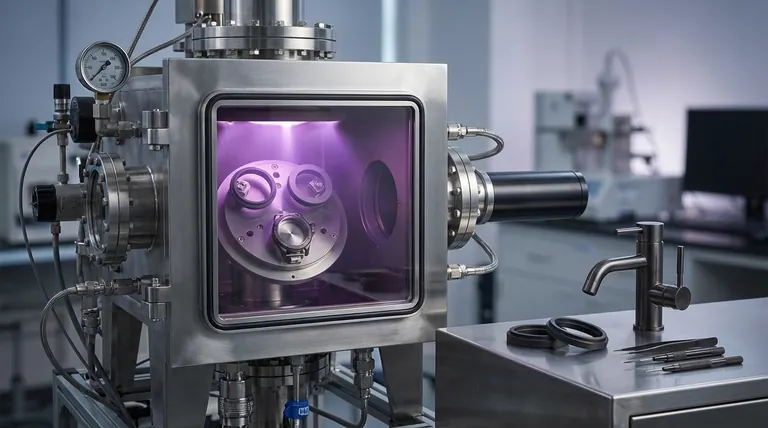In short, no. A properly applied Physical Vapor Deposition (PVD) coating does not tarnish. Its fundamental properties make it exceptionally resistant to the corrosion and oxidation that cause traditional metals to discolor and degrade over time.
The core reason PVD coatings don't tarnish is that the process is not a simple layer of paint or plating. Instead, it forms a new, chemically non-reactive surface at a molecular level, creating a barrier that is both incredibly hard and resistant to environmental attack.

How PVD Prevents Tarnish
It's a Molecular Bond, Not a Simple Layer
Traditional plating methods lay a separate layer of metal on top of a surface, which can wear away or react with the environment.
PVD is fundamentally different. In a high-vacuum chamber, a solid material (like titanium or zirconium) is vaporized into a plasma of atoms, which are then bonded to the target object's surface, forming a new, integrated finish.
This process creates a ceramic-like compound that is chemically inert, meaning it does not easily react with oxygen, moisture, or other elements that cause tarnish and corrosion.
The Result is Exceptional Hardness
PVD coatings are extremely hard—in some cases, approaching the hardness of a diamond. This durability is a key part of its resistance to degradation.
Because the surface is so difficult to scratch or chip, the underlying base metal is protected from exposure. Tarnish and rust often begin in small scratches where the protective layer has been breached.
Factors That Ensure PVD's Durability
The Importance of the Substrate
The final performance of a PVD coating is heavily dependent on the material it is applied to, known as the substrate.
High-quality stainless steel is an ideal substrate because of its inherent strength and corrosion resistance. Applying PVD to a less durable base metal can compromise the longevity of the entire product.
Controlled Engineering Process
The final characteristics of the coating—such as color, friction, and hardness—are precisely controlled during the PVD process.
Factors like coating thickness, which typically ranges from 0.5 to 5 microns, are engineered to provide optimal protection without changing the part's dimensions in a meaningful way. This precision ensures a uniform, reliable, and long-lasting finish.
Understanding the Limitations
PVD is Not Indestructible
While extremely durable and highly scratch-resistant, a PVD coating is not invincible. It can be damaged by extreme abrasion or gouged by sharp, hard objects.
However, for everyday use on products like watches, faucets, or jewelry, it offers a level of resilience far superior to traditional finishing methods.
What Looks Like "Tarnish" Is Usually Grime
In rare cases, users might see discoloration on a PVD surface. This is almost never the coating itself tarnishing.
Instead, it is typically an accumulation of dirt, oils, soap scum, or hard water minerals on the surface. This buildup can be cleaned off with a soft cloth and mild soap, restoring the original appearance of the PVD finish.
Quality of Application Matters
The effectiveness of a PVD coating is entirely dependent on the quality of its application. A rushed or poorly controlled process can result in a finish that fails prematurely. When choosing a PVD-coated product, the manufacturer's reputation for quality is a critical factor.
Making the Right Choice for Your Goal
When deciding if a PVD-coated product is right for you, consider your primary goal.
- If your primary focus is longevity and low maintenance: A PVD finish on a quality substrate like stainless steel is one of the most durable and tarnish-proof options available.
- If your primary focus is color permanence: PVD offers a fade-resistant color that will not change due to oxidation, making it ideal for maintaining a specific aesthetic over many years.
- If you are concerned about scratches: Choose PVD for its superior scratch resistance in daily use, but understand that no coating is completely scratch-proof against severe impact or abrasion.
Ultimately, choosing a product with a PVD coating is an investment in a durable, long-lasting finish that is engineered to resist degradation.
Summary Table:
| Property | Why It Prevents Tarnish |
|---|---|
| Molecular Bond | Forms a chemically inert, ceramic-like surface that doesn't react with oxygen or moisture. |
| Exceptional Hardness | Highly scratch-resistant, protecting the base metal from exposure and corrosion. |
| Engineered Thickness | A precise 0.5-5 micron layer provides optimal, uniform protection without altering part dimensions. |
Achieve Unmatched Durability for Your Laboratory Equipment
For lab equipment that demands a permanent, corrosion-resistant finish, the quality of the PVD coating is paramount. KINTEK specializes in providing high-performance lab equipment and consumables, ensuring that every component meets the highest standards of durability and reliability.
Let us help you select or customize equipment with a superior PVD finish that will stand up to harsh environments and frequent use, protecting your investment for years to come.
Contact our experts today to discuss how our PVD-coated solutions can enhance your lab's efficiency and longevity.
Visual Guide

Related Products
- Custom CVD Diamond Coating for Lab Applications
- RF PECVD System Radio Frequency Plasma-Enhanced Chemical Vapor Deposition RF PECVD
- Vacuum Hot Press Furnace Machine for Lamination and Heating
- Graphite Vacuum Continuous Graphitization Furnace
- 1700℃ Controlled Atmosphere Furnace Nitrogen Inert Atmosphere Furnace
People Also Ask
- How long does diamond coating last? Maximize Lifespan with the Right Coating for Your Application
- What is diamond coating film? A Thin Layer of Diamond for Extreme Performance
- Is diamond coating permanent? The Truth About Its Long-Lasting Durability
- Is diamond coating worth it? Maximize Component Life and Performance
- How are tools coated with diamond? Achieve Superior Hardness and Low Friction for Your Tools



















